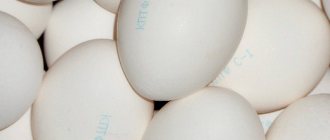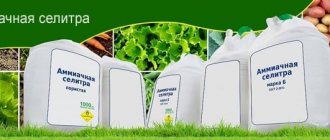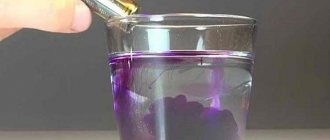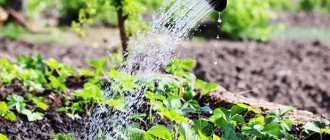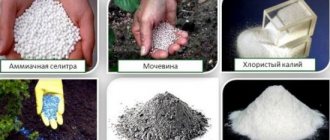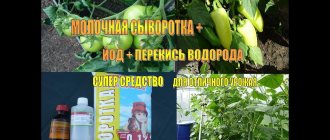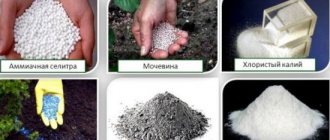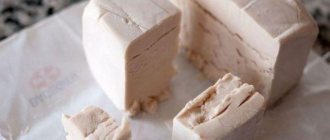Description
Urea is a concentrated nitrogen fertilizer, in the form of small, instant granules of white or transparent color. The substance is odorless. As the temperature increases, the solubility of the granules increases.
Kinds
Urea as a fertilizer has one composition, therefore it is not divided into varieties. The substance urea can be class A and B. Class A is used in industry. Class B in terms of nitrogen composition is suitable for feeding agricultural crops.
Compound
Urea is a chemical compound that consists of carbonic acid amide. Mass fraction of nitrogen 46.2%. Urea, whose formula is CO(NO2)2, is often the active ingredient in many complex fertilizers. According to GOST R 50568.1-93 on determining the amount of nitrogen, the substance can be used as a fertilizer in its pure form.
Properties
Urea is a highly effective substance that has the following properties:
| Properties | Characteristic |
| Solubility | Urea is highly soluble in water. The substance can also dissolve in ethanol and isopronol. |
| Melting | The granules melt at a temperature of +132.7°C. If you use a temperature above this value, the fertilizer turns into cyanuric acid. |
| Washability | Despite its good solubility, the substance has low leaching from the soil. |
| Decomposability | After being added to the soil, the granules decompose for a long time. |
| Acidifying effect | Minor. |
The fertilizer is more effective on light, slightly acidic soils.
Advantages and disadvantages
When choosing urea as a fertilizer for plants, you need to familiarize yourself with the advantages:
- universal use. Suitable for both root and foliar feeding. Does not cause burns on leaves;
- the result of fertilizing is noticeable a few days after application;
- urea quickly spreads throughout plant tissues;
- Spring treatment of plants delays flowering. Therefore, many summer residents treat trees so that spring frosts do not damage the flowers;
- Using urea you can eliminate many pests and fungal diseases.
There are many benefits to using urea. It is also important to know the disadvantages of fertilizer:
- failure to comply with the dosage may reduce seed germination;
- with frequent use, ammonia is released, which negatively affects young plants;
- The fertilizer must be stored in a dry place; the slightest contact with moisture can harm the granules.
When using other types of fertilizers on the site, urea must be applied no earlier than 14 days later.
Urea does not have good contact with this type of fertilizer such as wood ash. Therefore, to achieve the desired result, it is better not to combine such feedings.
Advantages and disadvantages of using urea
Fertilizing with urea is as effective as using saltpeter and other fertilizers containing nitrogen. It can be used for all vegetable and garden crops, for soil preparation and for seasonal applications.
Due to the high nitrogen content of urea, you will need 3 times less than nitrate, so purchasing it is economically profitable. Plants that cannot tolerate chlorine will not suffer from the use of urea; it does not contain this element. It lingers in the ground for a long time, so it is recommended to use it on sand and sandy loam, from which other mixtures are quickly washed out.
The disadvantages of urea as a fertilizer are that when applied to the soil it does not act immediately, therefore it is not suitable for emergency fertilizing, it acidifies the soil, and if the concentration in the soil is too high, it inhibits seed germination.
Methods of application
Urea as a fertilizer for plants is applied in three ways:
- directly into the ground. The granules are distributed over the area and covered with soil;
- solutions. To achieve quick results, urea is dissolved in water and the solution is watered at the root of the plant;
- leaf method. To feed plants, a weakly concentrated solution is prepared, which is distributed onto the above-ground part of the plants using a spray bottle.
In order not to harm the plant, it is not recommended to use two different methods at the same time. This can lead to high nitrogen concentrations and plant death.
Feeding cucumbers in a greenhouse: 6 useful tips to avoid spoiling the plant
Urea - What kind of fertilizer is this, what is it for?
Among the variety of fertilizers for the garden and vegetable garden, used both in spring and autumn, carbamide or urea is widely known. This fertilizer is in the form of white granules, containing 46% nitrogen. Urea is the richest nitrogen-containing fertilizer, has good solubility and is characterized by the absence of any odor. As the temperature increases, the solubility property increases. It is easy to appreciate the importance of using urea in gardening and gardening, knowing the importance of nitrogen fertilizer for all types of plants.
Urea fertilizer is used for:
- growth activation,
- obtaining abundant harvests,
- keeping plants healthy.
Urea is a good helper in the garden. Thanks to this approval, plants gain color well, have a bright green color, and bring a rich harvest.
It is worth taking the treatment of soil and plants with urea more seriously. A lack of nitrogen leads the plant to a depressive state, the appearance of barren flowers, and, accordingly, a poor harvest. Some plant species may simply die due to lack of nitrogen. It is also important not to overdo it with urea fertilizer. An excess of nitrogen also negatively affects plant development. It is worth carefully familiarizing yourself with the dosage of urea for each type of plant.
Instructions for using urea as a fertilizer
As a fertilizer, urea must be applied in the spring when digging up the site. Granules are added to the soil at the rate of 10 grams per 1 m2 and immediately covered with soil. With prolonged contact with air, urea loses its properties.
For root feeding during planting or during active growth, it is recommended to prepare a solution of 20 grams of urea per 10 liters of water. After preparation, the solution is used immediately, however, in order not to harm the roots, fertilizing must be done on pre-moistened soil.
Foliar feeding can be carried out throughout the growing season. The dosage may vary depending on the type of plant being grown. According to general standards, no more than 1 gram per liter of water is used for spraying.
For vegetables
Vegetable crops are most often fed using the root method. The dosage may vary depending on the type of plant. Fertilizing with urea should be carried out taking into account the following tips:
- pre-sowing work. As a rule, such work is carried out in early spring. After digging up the area, the granules are distributed in an even layer over the area. Using a rake, mix the fertilizer with the soil or water it generously. Otherwise, some of the nitrogen will evaporate and the effectiveness of fertilizing will decrease;
- during the seed planting period. Using this method, it is necessary to place 2-3 grams of the substance in each hole and sprinkle with soil. Only after this are the seeds or seedlings planted.
Repeated feeding with urea should be carried out no earlier than 15 days after the first application.
cucumbers
For cucumbers, fertilizer is used only 2 weeks after planting the seedlings. To feed with urea, you need to dissolve 15 grams of granules in 10 liters of liquid. When growing vegetables in greenhouse conditions, it is recommended to use foliar feeding. Fertilizer in an amount of 10 grams is dissolved in 10 liters of water and distributed evenly over the area.
Tomatoes
For tomatoes, urea fertilizer is used very often. In order to get a good harvest, the following features must be observed:
- when planting seedlings, 5 grams of the substance must be placed in each hole;
- After 3 weeks, foliar feeding is carried out at the rate of 1 gram per liter of water.
It is not recommended to use urea during the period of active flowering. This can stimulate side shoots to grow and buds to drop.
Cabbage
It is recommended to feed cabbage with urea once a season. Fertilizer is applied 10 days after planting the seedlings. For 10 liters of water, 20 grams of granules are used. The resulting solution is distributed over 1 m2. The same dosage is used for feeding wheat and other grains.
Garlic
Carbamide for garlic must be added in early June. To feed, 10 grams of granules are dissolved in a bucket of water. The resulting solution is applied to the pre-moistened area.
For greater effectiveness, it is recommended to add 10 grams of potassium chloride to the solution.
Strawberry
Fertilizer for strawberries is applied to the site in early spring immediately after the snow melts. No more than 10 grams of substance is used per 1 m2. If such standards are not observed, the crop will begin to form abundant foliage, and the berries will become small.
Tomato shoots and other “garbage” from the garden that can be used for the benefit of plants
Potato
For potatoes, fertilizer is recommended to be used during the planting of tubers. 5 grams of granules are placed in each well. Urea stimulates the rapid growth of sprouts and increases germination.
Solanaceae
For plants such as eggplant and pepper, it is necessary to apply fertilizer during the period of planting seedlings. 5 grams of substance are placed per well. After a few weeks, foliar feeding is carried out.
Peas
Legume plants also need nitrogen. Urea for legumes can be added during soil preparation. It is also permissible to fertilize with a solution after germination. The permissible dosage is no more than 1 gram per liter of water.
Beet
It is necessary to feed beets with fertilizer only in the spring. For culture, it is recommended to use 10 grams of granules per bucket of water.
Urea as a foliar fertilizer for beets is used only for symptoms of nitrogen deficiency. These include slow growth of seedlings and the formation of yellow spots on the leaves.
For fruit and berry crops
Urea is very popular as a fertilizer for garden trees and shrubs. The fertilizer can be used throughout the season. It can be applied either dry or in solution. In dry form for trees, apply 70-80 grams at the root and carefully cover with soil. The area should be watered generously from above. To prepare the solution, 80 grams are dissolved in water and the tree is watered generously.
For young bushes, a dosage of 60-70 grams is used. 80-90 grams of urea for adult spreading bushes.
For ornamental crops
As a fertilizer, urea can also be used for ornamental flowering plants. However, it must be remembered that ornamental plants are fed with urea only in the spring. Otherwise, the crop will not be able to form an inflorescence, but will grow foliage. To feed ornamental bushes, 4 grams of the substance are dissolved in a liter of water.
How to know that plants need urea: signs of nitrogen deficiency
A deficiency of the substance can be noticed by the appearance of the crop. Plants stop growing, the leaves become smaller, lose their normal green color and shine, the lower ones turn yellow, curl and fall off. Flowering occurs ahead of schedule, but the yield drops as few fruits are set.
An excess of nitrogen is also harmful to plants. This can be noticed by the increased growth of green parts and the dark green color of the foliage. In an overfed crop, the lower leaves curl and the fruits do not ripen well.
Application against pests
Urea is used in pest and disease control. However, this method is effective only if it is used in the spring before the plants awaken.
From pests
To combat pests such as weevils and aphids, it is necessary to dissolve 30 grams of urea in 10 liters of liquid. The plant is treated generously with the resulting solution. However, treatment must be carried out in early spring at an air temperature of no more than +5 degrees. It is forbidden to process crops that have budded. This may cause flowers to fall off.
From diseases
To protect plants from fungal diseases, the procedure must be carried out immediately after the snow melts. 25 grams of urea are used for 1 bucket. The resulting solution is sprayed onto trees and shrubs.
Norms for fertilizing with urea
The simplest use of urea is to add 20 g of the drug per 1 square meter. m. when digging the ground. The earlier in the spring it gets into the soil, the less nitrogen is lost. Nitrogen evaporates easily in warm weather.
To prepare the solution, most often take 1 tablespoon or 1 matchbox of the product per bucket of water. 1 tablespoon contains 10-12 g. substances, in 1 matchbox 13-15 g. drug
When feeding:
- cabbage, beets, onions, peppers, tomatoes, garlic and potatoes - the norm is 19-23 g / m2.
- for cucumbers or peas add about 6-9 g/m2.
- For zucchini and eggplants, add 10-12 g/m2.
Fertilizing is carried out 2 times during the entire growth period, the first time during planting, and the second time at the beginning of fruit formation.
FAQ
In order for the use of urea as a fertilizer to be effective, the dosage must be observed. Summer residents often have the following questions.
Where to buy urea?
You can purchase urea at any specialized store that sells seeds and fertilizers.
How to store urea?
To ensure that the granules do not lose their characteristics, the fertilizer must be stored in a plastic bag. For storage, select a dry place, protected from direct sunlight.
Is there a danger to humans?
Urea is a harmful substance for humans. Therefore, if it enters the body, you must contact a medical facility. During fruit ripening, it is not recommended to treat with urea. The fruits can be consumed 10 days after applying fertilizers.
Is it possible to apply urea in the fall?
Fertilizer can be applied in the fall during the period of digging up the site. However, the effectiveness of fertilizing is reduced.
Can urea be mixed with other fertilizers?
It is not advisable to mix urea with other fertilizers. Summer residents should remember that urea does not mix with phosphorus, chalk and lime.
Is it possible to harm plants by fertilizing with urea?
Yes, excessive use of urea can harm plants. With a large amount of nitrogen, the crop grows poorly, it may shed leaves and not form buds.
What is the difference between urea and ammonium nitrate?
Ammonium nitrate and urea belong to the same class of fertilizers. Therefore, summer residents are often confused. The following distinguishing criteria need to be considered. August root feeding of cucumbers with homemade complex fertilizer to increase yield
| Distinctive feature | Urea | Ammonium nitrate |
| Compound | Nitrogen content 46.2 | Nitrogen content 36 |
| Impact on soil and plants | Gradually breaks down and slowly affects the plant | Refers to fast-acting fertilizers |
| Application | Can be used for both root and foliar feeding | Suitable for root application only. Foliar feeding causes burns. |
Saltpeter can be used throughout the season. While urea is most often used in the spring.
Urea for spraying trees
Foliar feeding is carried out with liquid nutrients that plants absorb through the leaves. The use of urea for spraying trees has its advantages:
- prolongs the pollination period;
- promotes early ripening of fruits;
- increases crop resistance to diseases.
Trees are sprayed to prevent diseases and for feeding purposes.
To combat scab, monilium blight and purple spots: 0.5 kg of granules are diluted in 10 liters of water. Plants are sprayed at the end of summer, before the leaves fall.
Treatment can be carried out in late autumn, before the first frost, but in this case you will need 0.7 kg of granules per bucket of water. If trees are treated at the rate of 250 ml of solution per square meter, the pests will be destroyed.
For foliar feeding, use 30-50 g. substances per 10 liters of water. This is done in early spring, before the buds open.
Under what conditions and in what quantities can seedlings be watered with urea?
Urea can be used both for watering seedlings and soil before planting some crops.
During the growing season, the following plants are watered with this fertilizer:
Before planting vegetables or berries:
The soil on which it is planned to plant berry or vegetable crops can be fertilized with granulated urea in a ratio of 5 to 11 grams per cubic meter. Most often, about 60 percent of the product is added in the fall before the soil is dug, and the remainder in the spring.
In what proportions should urea be diluted to feed fruit trees and berry bushes?
In order to ensure good growth and development of such plants, the soil is watered with a urea solution and this product is very rarely used in granules - unless it is added to the soil before planting the seedling.
As for the urea solution, it is used to water the area in which the roots are located (the trunk circle), as well as the trunk strips of the plant. If you still use granulated urea, then later you will need to increase the watering of the plant.
When diluting the solution, the following proportions should be taken into account:
It should be remembered that excess nitrogen fertilizers can negatively affect the development of seedlings: rapid growth of the green mass of the plant may begin while the development of fruits is inhibited.
Attention! If you don’t have measuring scales at your dacha, and you don’t know how to measure the required amount of urea, you can take as much as you need using improvised means:
Using this information, you can select the required amount of urea for watering seedlings.
Urea - instructions on how to apply fertilizer correctly
The best time to treat the soil with urea
The best time to apply urea to the soil is the period of flowering of garden plants and before fruiting of garden crops.
By this time, the soil is sufficiently depleted, and signs of nitrogen deficiency in plants are most clearly visible. It is worth choosing calm weather after heavy rainfall: this will allow nitrogen to penetrate into the deeper layers of the soil. There is no point in using urea before planting, since nitrogen particles are quickly washed out of the soil by precipitation.
When does a plant need urea fertilization?
During the development of a plant, it is important to pay close attention to its appearance. The condition of the plant will indicate the need to apply fertilizer. Having decided to use urea, you need to make sure that nitrogen fertilizers are necessary. Lack of nitrogen affects the appearance of the plant:
- The plant remains in the sprouting stage for a long time (does not grow into a mature plant);
- A mature plant has small shoots and bare branches;
- The leaves are unformed, have white pigmentation, and often fall off.
If the plant does not have the above signs, grows well and has a rich green color, do not rush to fertilize with urea.
Urea can also be used to prevent a lack of nitrogenous elements in the soil. There is no need to wait for obvious signs of nitrogen deficiency. Prevention will help improve the condition of plants and prevent a decline in yield.
How much superphosphate is in a tablespoon. Garden arithmetic: how to measure fertilizers
How to measure the right amount of fertilizer using available tools.
You've probably found yourself in a situation where you have nothing to measure fertilizer with. There is a way out - use simple, familiar items that are almost always at hand. Simple garden arithmetic to help you!
Matchbox
In it you can measure:
19 g ammonium sulfate, 17 g ammonium nitrate, 13 g urea, 22 g simple granulated superphosphate, 20 g double superphosphate, 35 g phosphate rock, 19 g potassium chloride, 22 g, 26 g potassium sulfate, 34 g dolomite flour, 30 g limestone flour, 12 g slaked lime, 10 g wood ash, 8 g peat ash, 20 g nitrophoska.
Tablespoon
It will fit:
14 g ammonium sulfate, 12 g ammonium nitrate, 10 g urea, 17 g simple granulated superphosphate, 15 g double superphosphate, 26 g, 14 g potassium chloride, 17 g potassium salt, 20 g potassium sulfate, 25 g dorlomite flour, 22 g limestone flour, 9 g slaked lime, 8 g wood or 6 g peat ash, 15 g nitrophoska.
Tea spoon
This is 4 g of ammonium nitrate, 3 g of urea, 5 g of nitrophoska, 5 g of simple granulated superphosphate, 5 g of double superphosphate, 5 g of potassium chloride, 5 g of ammonium sulfate, 5 g of potassium salt, 9 g of phosphate rock, 6 g of potassium sulfate , 8 g dolomite 8 g limestone flour, 3 g slaked lime, 2.5 g wood ash, 2 g peat ash.
Glass 200 ml
With it you can measure 200 g of nitrophoska and double superphosphate, 186 g of ammonium sulfate, 165 g of ammonium nitrate, 130 g of urea, 220 g of potassium salt, 220 g of simple granulated superphosphate, 350 g of phosphate rock, 190 g of potassium chloride, 260 g of potassium sulfate , 340 g of dolomite flour, 300 g of limestone flour, 120 g of slaked lime, 100 g of wood and 80 g of peat ash.
Bucket 10 l
Contains: 8 kg of fresh horse manure, 5 kg of horse manure, but on a bed of sawdust, 9 kg of fresh mullein, 5 kg of dry peat, 5 kg of wood ash, 5 kg of bird droppings, 8 kg of humus, 12 kg of turf soil, 10 kg of old greenhouse or compost soil.
Interaction with other fertilizers
When interacting with various chemicals, urea fertilizer produces reactions. There are successful and unsuccessful combinations. Potassium chloride, potassium sulfate, sodium nitrate, manure will enhance the properties of urea. But it is better not to mix with gypsum, chalk, dolomite, and calcium nitrate. They inhibit the usefulness of urea, fertilizing will not bring the expected result.
Knowing that fertilizer does not absorb water, but dissolves easily in it, store it tightly packed in a dry place. It is quite acceptable to keep granules at sub-zero temperatures, but remember that the expiration date is written on the packaging.
Attention!
Do not use fertilizer after the expiration date. Fertilizers in liquid form do not freeze.
Urea: pros and cons as a fertilizer for flowers
Urea is an inorganic fertilizer that is gradually absorbed by plants and is the leader in nitrogen content - 46%.
Main advantages:
- it takes virtually no time for plants to absorb nutrients;
- easily absorbed;
- rapid dissolution in water;
- rich color of green mass (dense stems, bright leaves);
- active formation of buds (flower buds), lush flowering;
- ensuring rapid growth;
- urea is convenient for nutrition (feeding) because it is used in the form of granules;
- liquid solution;
- soluble tablets;
The disadvantages include:
- quick solubility is not always good, because it easily disappears with groundwater;
- strict dosage is necessary, otherwise it causes the destruction of soil microflora;
- Excessive consumption of the nutrient can turn part of the fertile soil into ammonia.
Composition and properties of urea
Urea is a carbonic acid diamide, almost half of which is nitrogen. This fertilizer is produced in the form of water-soluble crystals from transparent to white-yellowish, powder and tablets. Intended for feeding garden, vegetable and indoor plants.
Many inexperienced flower growers wonder whether it is possible to feed flowers with urea. Answer: Of course you can, especially if you want to grow lush greens.
Urea is a very popular fertilizer for plants.
Fertilizing of vegetable and fruit crops
The use of urea gives good results when used as a means of feeding fruit plants and vegetable crops. In order to increase productivity and accelerate plant growth, fertilizing is carried out during the growing season by irrigating the root zone. The solution should be poured directly under the root of a tree or bush. This will make it easier for the plant to absorb nutrients.
Foliar feeding is carried out using manual spraying. It is better to carry out the procedure in the morning or evening. A urea solution with a concentration below 5 percent is safe for leaves, unlike ammonium nitrate.
Features of feeding indoor flowers:
(adsbygoogle = window.adsbygoogle || []).push({});
- fertilize depending on the time of year:
- winter – once a month,
- spring - summer - weekly,
- autumn – once every 2-3 weeks;
- The growth rate of a flower crop matters:
- fast growing – weekly,
- slow - every month.
Foliar feeding by spraying a urea solution is carried out at the beginning of development to activate its growth. Prepare the solution required for treatment at the rate of 10-15 ml per flower crop and in the proportion of 1 liter of water per 7-10 grams.
When laying compost, you should pay attention to the materials of the laying. If these are materials that cause carbon reactions (sawdust, straw, leaves, grass, paper), which can heat up to 60 degrees in a heap, you need to add urea in a ratio of 1 kg/1 sq.m.
Urea as a fertilizer for indoor plants
If you carefully use urea according to the instructions, then even the most ordinary lawn with grass will delight you with bright and juicy greenery that retains its rich color for a long time.
